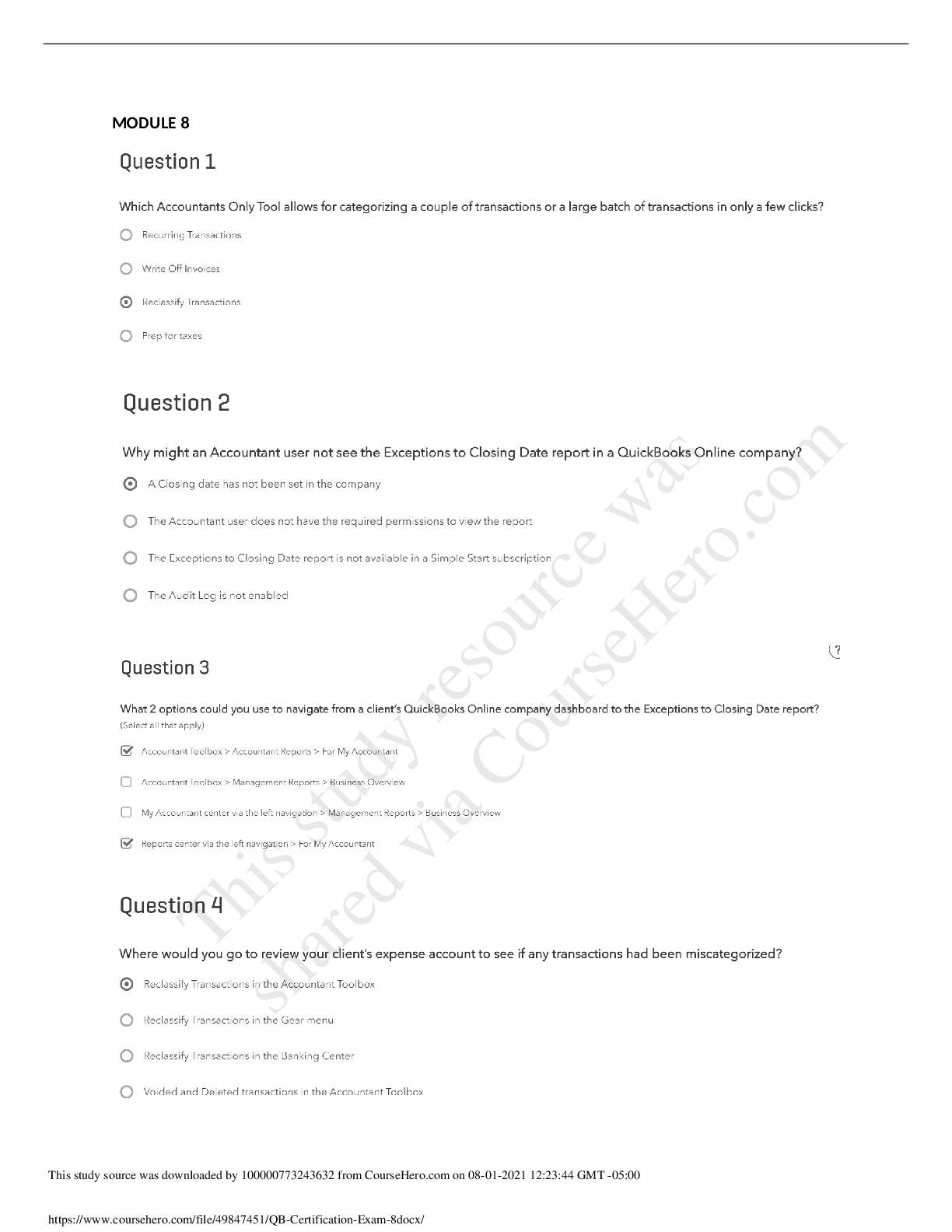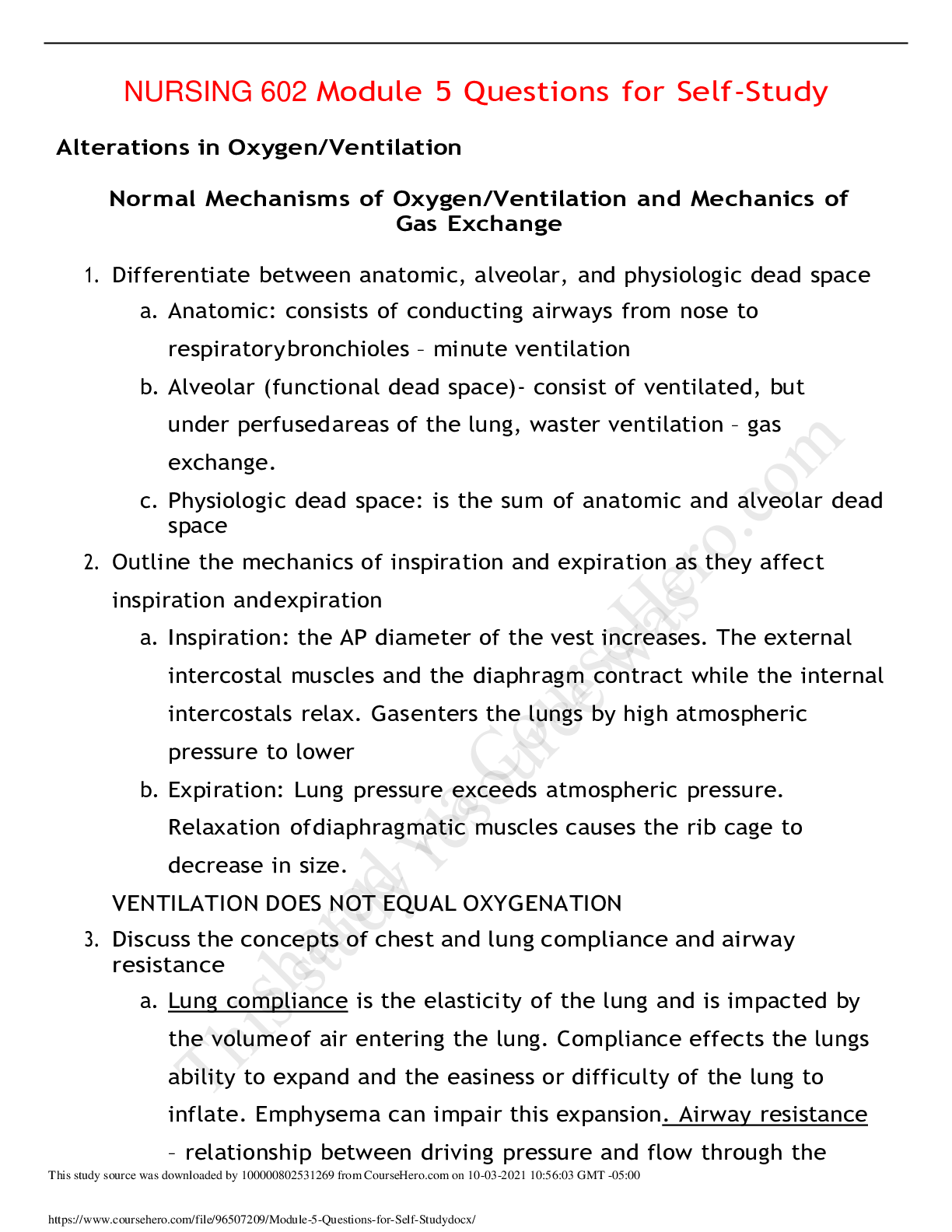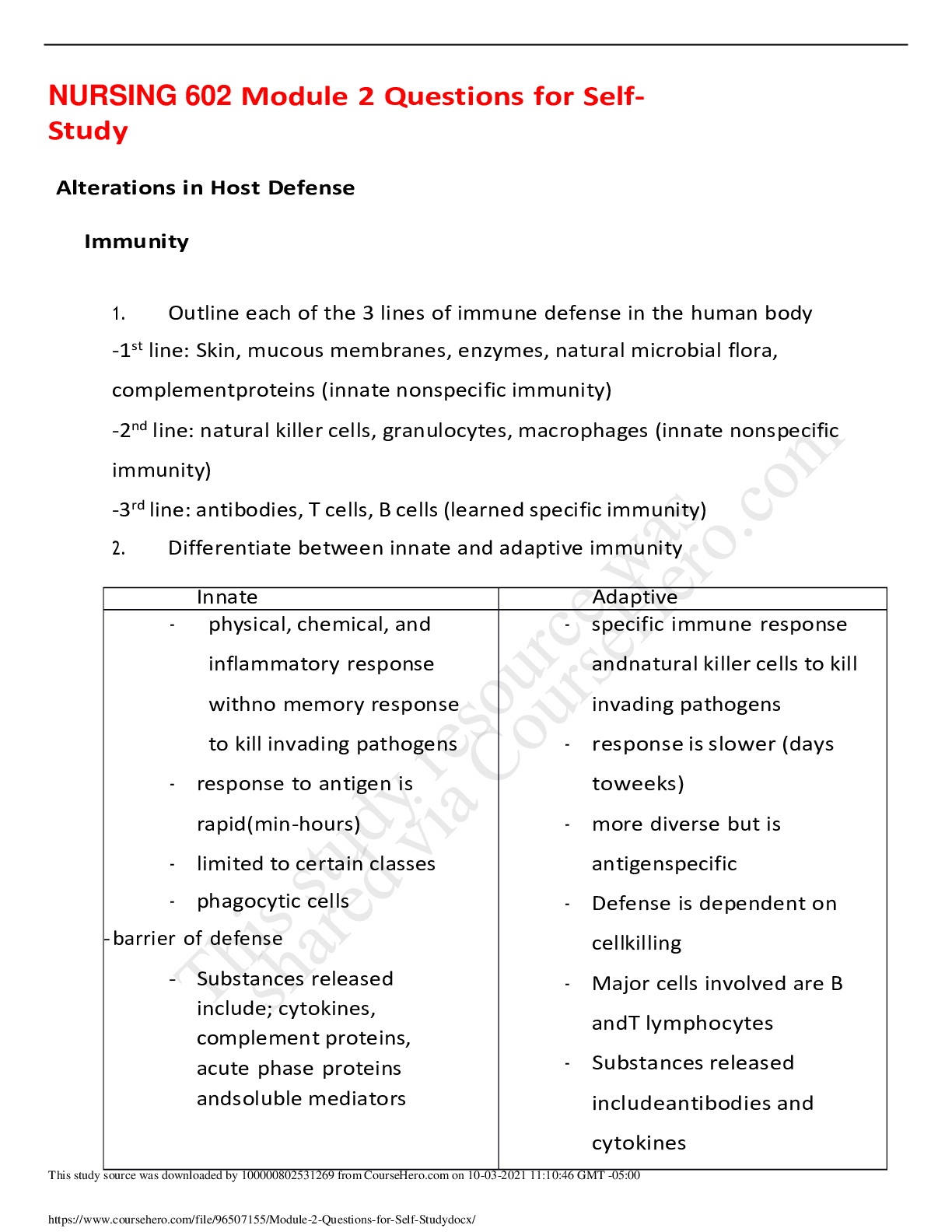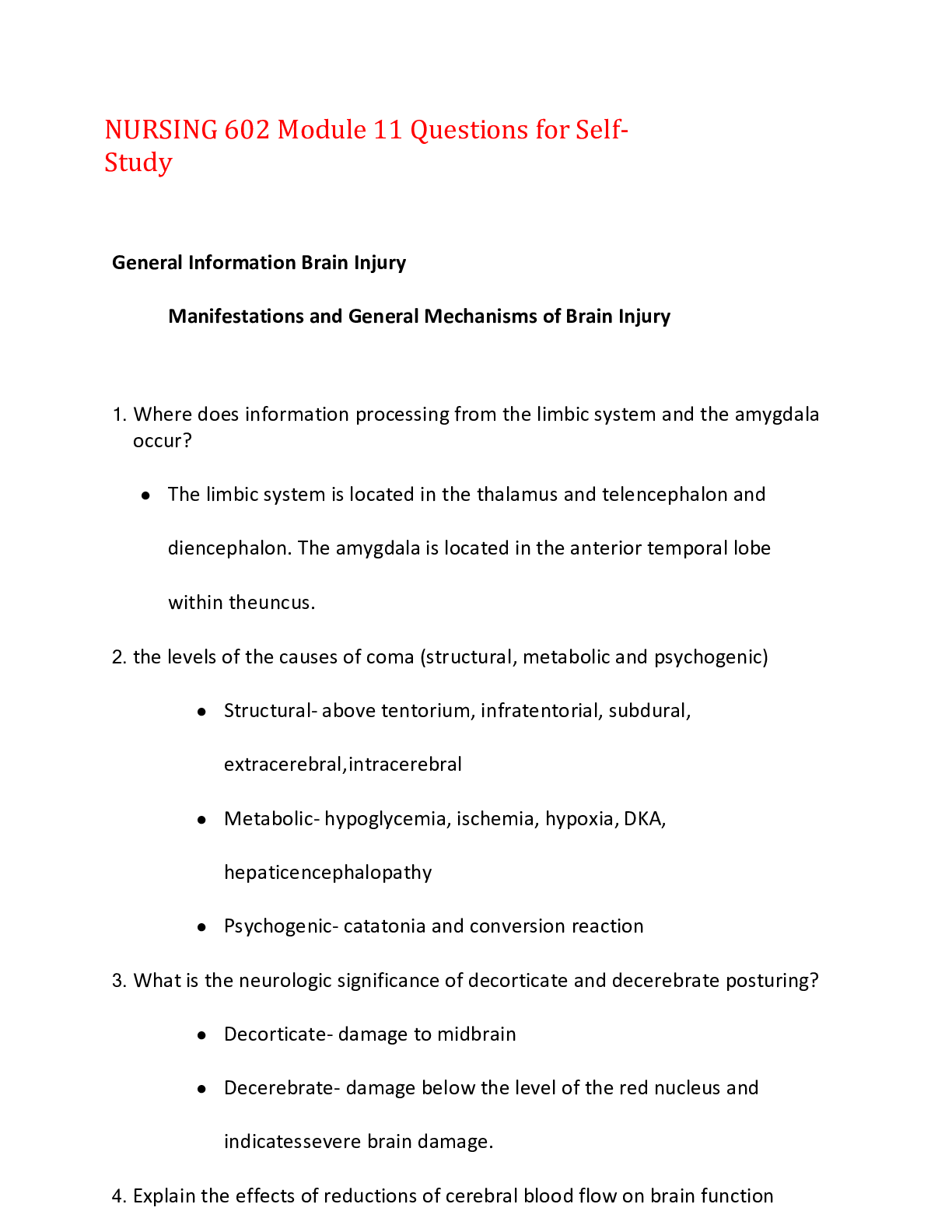NURSING 602 Module 8 Questions for Self-Study,100% CORRECT
Document Content and Description Below
NURSING 602 Module 8 Questions for Self-Study Absorption of Nutrients and Energy Balance 1. Outline the elements of mechanical work, signal transduction, heat production, detoxification/degradat... ion, membrane transport and synthetic reactions that require sufficient absorption of nutrients a. Mechanical work- breaks down molecules into smaller ones b. Signal transduction- the smell of food of taste, triggers saliva which contains the enzyme amylase to breakdown food c. Detoxification- liver enzymes, kidney function, and bowel function d. Membrane transport- ATP and transport chain proteins 2. List where processing, absorption and metabolism of carbohydrates, fats and proteins occurs a. Carbohydrates: absorbed against the upper and lower parts of the small intestine, transferred into the blood stream and carried to muscles and the liver b. Fats: absorbed in the small intestine, then transported in chylomicrons via the lymphatic system into the bloodstream, where they reach the liver, peripheral tissues and adipose tissues c. Proteins: absorbed in the duodenum or jejunum of the small intestine. One synthesized into amino acids or peptides, they are transported to the liver by the hepatic portal vein. Thyroid/Thyroid Hormones 1. Describe the regulation and actions of thyroglobulin (TG), TRH, TSH, T3 and T4. Which substance is the most metabolically active? a. T3- when iodine is deficient b. T4-Regulates the production of TSH c. TRH-stimulates thyrotropes of the anterior pituitary to secrete TSH d. TSH-stimulates the thyroid follicle cells to produce and secret the thyroid hormones 2. Why is the iodine trap important? a. The thyroid gland traps iodine and combines the iodine with the amino acid tyrosine to form thyroid hormones 3. Outline the effects of thyroid hormones on BMR and metabolism in general a. Thyroid hormones help you burn fat and provide you with more energy. This effect on fat metabolism bumps up the BMR and means you’ll be burning off fat even when not physically active. Common Types of Thyroid Dysfunction 1. What are the physiologic consequences of thyroid hormone deficiency and excess? a. Hypothyroidism- weight gain, cold intolerance, bradycardia b. Hyperthyroidism- graves disease, plummer’s disease, thyrotoxicosis 2. Describe changes in TH, TSH and TRH levels in hypothyroidism caused by malfunction in the thyroid gland, hypothalamus, or the pituitary a. Thyroid gland- TH decreases, TSH decreases, and TRH b. Hypothalamus- where peptides released by posterior pituitary are synthesized c. Pituitary- 3. What is the clinical manifestation of hypo and hyperthyroidism (be sure to give the physiologic these occur? a. Hypo- fatigue, weight gain, increased cholesterol, increased cold sensitivity, dry skin, puffy face, hoarseness, dry hair, muscle weakness b. Hyper- swollen thyroid gland, prominent eyes, increased metabolic rte, irregular heartbeat, increased blood pressure, hot flashes 4. Describe causes and consequences of myxedema and thyroid storm? a. Myxedema- hypothyroidism, a loss of brain function as a result of severe, longstanding low level of thyroid hormone in the blood b. Thyroid storm- hyperthyroidism, triggered by a stressful event like sepsis, fever, dehydration, MI, and psychiatric disease Liver’s Role in Metabolism 1. Outline the functions of the liver in the metabolism of carbohydrates, fats, and proteins a. Carbs- stored in the liver as glycogen, stimulated insulin release b. Fats- lipoproteins are synthesized in the liver. The liver synthesizes large quantities of cholesterol and phospholipids c. Proteins- synthesis of on-essential amino acids, synthesis of plasma proteins, Common Clinical Manifestations/Features of Liver Dysfunction 1. Describe the general consequences of liver disease a. Cirrhosis that can lead to liver failure 2. Outline the pathophysiologic mechanisms for the clinical presentation/features of liver disease a. Nausea, vomiting, right upper quadrants abdominal pain, jaundice Hepatitis 1. Describe the clinical phases in the development of hepatitis a. Phase I- viral replication, pt is asymptomatic b. Phase II – prodromal phase, pt is anorexia, N/V, alterations in taste c. Phase III- icteric phase 2. List the transmission routes of Hepatitis A, B and C a. A- Fecal b. B- Blood and bodily fluids c. C- Blood 3. What does the presence of HBsAg, HBcAg, HBeAg, ABeAb and ABsAb in the serum mean about hepatitis B infection? a. The person is infectious 4. Describe the liver consequences of hepatitis related to alcohol abuse a. Scar tissue can slow blood flow through your liver, increasing pressure in a major blood vessel (portal vein), and the buildup of toxins Cirrhosis and Complications of Liver Disease Portal Hypertension and GI Varices 1. Describe the clinical manifestations of portal hypertension and the reason that these occur a. GI bleeding (black tarry stools), ascites (accumulation of fluid in the abd.), encephalopathy (confusion) 2. Describe the pathophysiology of cirrhosis and stages of cirrhosis progression a. Stage I- inflammation b. Stage II- accumulation of scar tissue but with liver function c. Stage III- extensive fibrosis and scarring but with normal functioning d. Stage III- substantial cirrhosis damaging liver and impairing vital functions 3. Explain why the clinical manifestations of cirrhosis occur a. Weakness, fatigue, poor appetite, loosing weight, N/V, mild pain 4. Explain the pathophysiology of the development of gastric varices a. With the increased pressure the portal veins, blood is pushed away from the liver an into smaller blood vessels 5. What are the early clinical manifestations of gastric varices? a. Tarry and bloody stools, vomiting blood, hypotension, high heart rate, dizziness, and shock Hepatic Encephalopathy 1. What is hepatic encephalopathy and what precipitates its development? a. Develops because of severe liver disease, caused by exposure to alcohol, chemicals, drugs and supplements. 2. Describe the clinical features/manifestations of hepatic encephalopathy a. Confusion, drowsiness, anxiety, seizures, fatigue, confused speech, slow movements Diabetes Mellitus and Metabolic Syndrome Role of Insulin 1. Describe the anabolic effects of insulin and the catabolic effects of glucagon on target tissues a. Anabolic effects- promote collagen production by osteoblasts b. Catabolic effects- insulin promotes muscle protein synthesis only in the presence of a high concentration of amino acids 2. List the inhibitory and stimulatory factors for insulin secretion a. Osteitides acts primarily on somatostatin receptor subtypes II and V. It also inhibits growth hormone secretion and has a multitude od other endocrine effects Type 1 DM and Type 2 DM, Chronic Complications, and Metabolic Syndrome 1. Differentiate between the pathophysiology of Diabetes Mellitus type 1 and type 2. a. Type I- culmination of lymphocytic infiltration and destruction of insulin- secreting beta cells of the islets of Langerhans in the pancreases b. Type II- high levels of sugar in the blood stream. The body is unable to metabolize the glucose 2. Outline the pathophysiology underlying the clinical manifestations/features of Diabetes Mellitus 3. What are some of the chronic complications of Diabetes Mellitus? a. Loss of limbs, neuropathy, nephropathy, and macrovascular problems. 4. What are the hallmarks of metabolic syndrome in the vasculature, the liver, the kidney, the eye and in adipose tissue? a. Vasculature- decreased incretin effect b. Kidney- increased glucose reabsorption c. Adipose tissue- increased lipolysis Disorders of Acquisition and Processing of Nutrients in Upper GI GERD 1. What is the pathophysiology of gastroesophageal reflux disease (GERD)? a. Prolonged exposure of acid in the esophagus. The sphincter relaxes abnormally or weakens causing a back up flow of acid 2. Describe causes of the clinical presentation/features of GERD a. Burning in chest, chest pain, difficulty swallowing, regurgitation of food, lump in your throat PUD 1. What is the pathophysiology of peptic ulcer disease (PUD)? a. The digestive tract is coated with a mucous layer that normally protects against acid. If the acid is decreased, an ulcer may develop 2. Describe causes of the clinical presentation/features of PUD a. Bloating, burping, poor appetite, vomiting, weight loss Celiac Disease 1. What is the pathophysiology of celiac disease? a. HLA-DQ2 and HLA-DQ8 present antigen derived peptides to CD4 T cells. 2. Why is celiac disease associated with malnutrition? a. The absorption of nutrients is hindered 3. What is the clinical presentation/features of celiac disease? a. Diarrhea, fatigue, weight loss, bloating and gas, abdominal pain, N/V [Show More]
Last updated: 1 year ago
Preview 1 out of 11 pages

Buy this document to get the full access instantly
Instant Download Access after purchase
Add to cartInstant download
We Accept:

Reviews( 0 )
$13.00
Document information
Connected school, study & course
About the document
Uploaded On
Sep 30, 2021
Number of pages
11
Written in
Additional information
This document has been written for:
Uploaded
Sep 30, 2021
Downloads
0
Views
31























